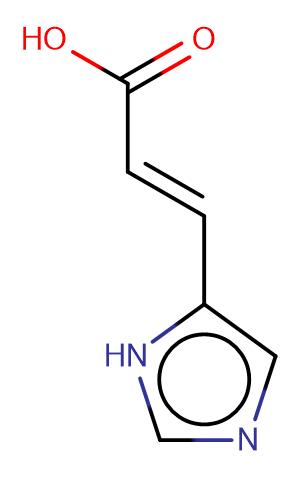
Urocanic acid
CAS No. 104-98-3
Urocanic acid( 4-Imidazoleacrylic acid )
Catalog No. M19542 CAS No. 104-98-3
Urocanic acid produced in the upper layers of mammalian skin is a major absorber of ultraviolet radiation.
Purity : >98% (HPLC)
 COA
COA
 Datasheet
Datasheet
 HNMR
HNMR
 HPLC
HPLC
 MSDS
MSDS
 Handing Instructions
Handing Instructions
| Size | Price / USD | Stock | Quantity |
| 1G | 43 | In Stock |


|
Biological Information
-
Product NameUrocanic acid
-
NoteResearch use only, not for human use.
-
Brief DescriptionUrocanic acid produced in the upper layers of mammalian skin is a major absorber of ultraviolet radiation.
-
DescriptionUrocanic acid produced in the upper layers of mammalian skin is a major absorber of ultraviolet radiation.(In Vitro):Urocanic acid (UCA) is formed in the upper layers of the epidermis where filaggrin, a histidine-rich filamentous protein produced after caspase-14 cleavage of profilaggrin, is broken down by proteinases into component amino acids.
-
In VitroUrocanic acid (UCA) is formed in the upper layers of the epidermis where filaggrin, a histidine-rich filamentous protein produced after caspase-14 cleavage of profilaggrin, is broken down by proteinases into component amino acids.
-
In Vivo——
-
Synonyms4-Imidazoleacrylic acid
-
PathwayOthers
-
TargetOther Targets
-
RecptorOthers
-
Research AreaInflammation/Immunology
-
IndicationDry eyes
Chemical Information
-
CAS Number104-98-3
-
Formula Weight138.12
-
Molecular FormulaC6H6N2O2
-
Purity>98% (HPLC)
-
SolubilityDMSO: 10 mM
-
SMILESOC(=O)\C=C\c1cnc[nH]1
-
Chemical Name——
Shipping & Storage Information
-
Storage(-20℃)
-
ShippingWith Ice Pack
-
Stability≥ 2 years
Reference
1.Gibbs NK et al. Recent advances in urocanic acid photochemistry photobiology and photoimmunology. Photochem Photobiol Sci. 2008 Jun;7(6):655-67.
molnova catalog



related products
-
4-Hydroxy-3-nitrophe...
It is a small molecular drug, active to Ig heavy chain V-I region and Ig gamma-2 chain C region.
-
N20C hydrochloride
NMDA receptor antagonist.
-
2,2′-Dithiodipyridin...
2,2'-Dipyridyl disulfide is a useful reagent for determination of sulfhydryl groups, preparation of amino acid active esters and the thio esters of phosphoric acid.



 Cart
Cart
 sales@molnova.com
sales@molnova.com


